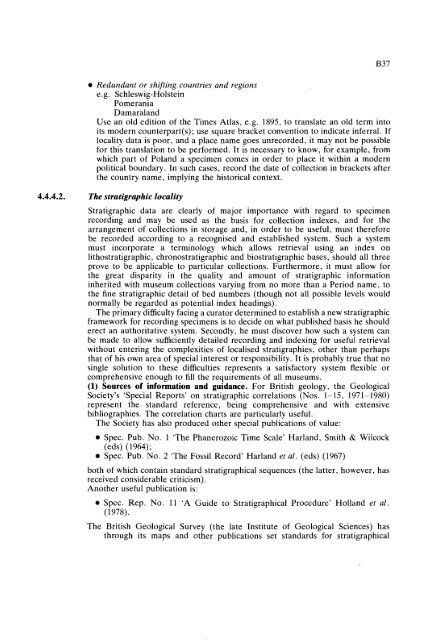GUIDELINES FOR THE CURATION OF GEOLOGICAL MATERIALS
GUIDELINES FOR THE CURATION OF GEOLOGICAL MATERIALS
GUIDELINES FOR THE CURATION OF GEOLOGICAL MATERIALS
Create successful ePaper yourself
Turn your PDF publications into a flip-book with our unique Google optimized e-Paper software.
Redundant or shifting countries and regions<br />
e.g. Schleswig-Holstein<br />
Pomerania<br />
Damaraland<br />
Use an old edition of the Times Atlas, e.g. 1895, to translate an old term into<br />
its modern counterpart(s); use square bracket convention to indicate inferral. If<br />
locality data is poor, and a place name goes unrecorded, it may not be possible<br />
for this translation to be performed. It is necessary to know, for example, from<br />
which part of Poland a specimen comes in order to place it within a modern<br />
political boundary. In such cases, record the date of collection in brackets after<br />
the country name, implying the historical context.<br />
4.4.4.2. The stratigraphic locality<br />
Stratigraphic data are clearly of major importance with regard to specimen<br />
recording and may be used as the basis for collection indexes, and for the<br />
arrangement of collections in storage and, in order to be useful, must therefore<br />
be recorded according to a recognised and established system. Such a system<br />
must incorporate a terminology which allows retrieval using an index on<br />
lithostratigraphic, chronostratigraphic and biostratigraphic bases, should all three<br />
prove to be applicable to particular collections. Furthermore, it must allow for<br />
the great disparity in the quality and amount of stratigraphic information<br />
inherited with museum collections varying from no more than a Period name, to<br />
the fine stratigraphic detail of bed numbers (though not all possible levels would<br />
normally be regarded as potential index headings).<br />
The primary difficulty facing a curator determined to establish a new stratigraphic<br />
framework for recording specimens is to decide on what published basis he should<br />
erect an authoritative system. Secondly, he must discover how such a system can<br />
be made to allow sufficiently detailed recording and indexing for useful retrieval<br />
without entering the complexities of localised stratigraphies, other than perhaps<br />
that of his own area of special interest or responsibility. It is probably true that no<br />
single solution to these difficulties represents a satisfactory system flexible or<br />
comprehensive enough to fill the requirements of all museums.<br />
(1) Sources of information and guidance. For British geology, the Geological<br />
Society's 'Special Reports' on stratigraphic correlations (Nos. 1-15, 1971-1980)<br />
represent the standard reference, being comprehensive and with extensive<br />
bibliographies. The correlation charts are particularly useful.<br />
The Society has also produced other special publications of value:<br />
Spec. Pub. No. 1 'The Phanerozoic Time Scale' Harland, Smith & Wilcock<br />
(eds) (1964);<br />
Spec. Pub. No. 2 'The Fossil Record' Harland et al. (eds) (1967)<br />
both of which contain standard stratigraphical sequences (the latter, however, has<br />
received considerable criticism).<br />
Another useful publication is:<br />
Spec. Rep. No. 11 'A Guide to Stratigraphical Procedure' Holland et al.<br />
(1978).<br />
The British Geological Survey (the late Institute of Geological Sciences) has<br />
through its maps and other publications set standards for stratigraphical

















